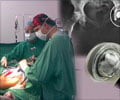Researchers at Tel Aviv University and New York University have developed a unique application of magnetic resonance imaging (MRI) technology that provides a non-invasive early diagnosis
A unique application of magnetic resonance imaging (MRI) technology that provides a non-invasive early diagnosis of osteoarthritis has been developed by researchers at Tel Aviv University and New York University.
Till date, osteoarthritis could not be detected before it reaches an advanced stage, after both irreversible joint damage and severe symptoms have already set in.However, the results from the new tests, which cost the same as a standard MRI, could be read within one day.
"An early diagnosis of arthritis is very, very important, especially for athletes and the aging," said Prof. Gil Navon, from Tel Aviv University's School of Chemistry, who was a coauthor of the research paper.
He added: "Standard MRIs will say nothing about a mild pain in the joints from jogging. Our new method detects the very first signs of the disease early, so physicians can step in and advise on appropriate intervention methods."
He also pointed out that the new technique will be a useful tool for researchers who need to monitor the ability of stem cell treatments to repair damaged cartilage.
It will also give drug researchers a much-needed means of determining the efficacy of early preventative drug therapies.
Advertisement
Cartilage consists of two main constituents- collagen and proteoglycans. Proteoglycans are composed of a protein and a sugar known as glycosaminoglycan (GAG). In the first stage of osteoarthritis, proteoglycans start to disappear from the cartilage.
Advertisement
The new invention follows the movement of GAG protons to water, providing a new, direct way to measure GAG concentration as well as an early diagnosis.
While the modified MRI test is not yet available in clinics, it still costs the same as a conventional MRI procedure and takes about the same time to run, allowing a diagnosis on the same day, the researchers reported.
"I'm pretty confident in saying that it's one of the better methods out there for testing cartilage health," said New York University researcher and co-author Prof. Alexej Jerschow.
The study is published in the Proceedings of the National Academy of Science.
Source-ANI
RAS/SK














